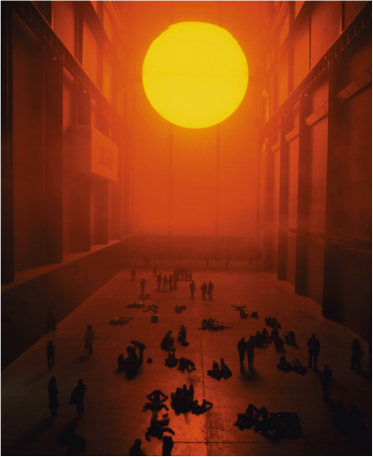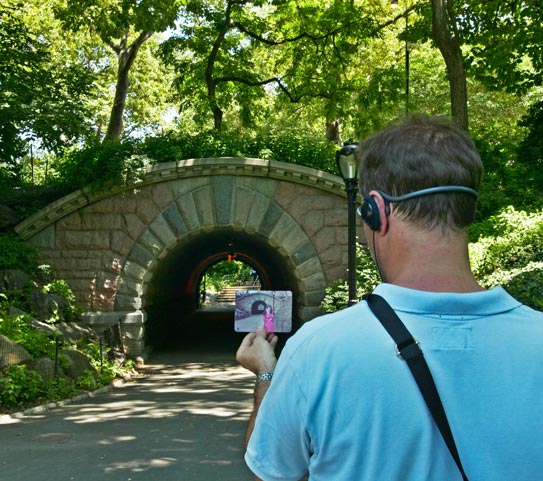-
Paper Information
- Paper Submission
-
Journal Information
- About This Journal
- Editorial Board
- Current Issue
- Archive
- Author Guidelines
- Contact Us
International Journal of Arts
p-ISSN: 2168-4995 e-ISSN: 2168-5002
2018; 8(2): 25-29
doi:10.5923/j.arts.20180802.01

Spaces of Participation and Memory in the Work of Olafur Eliasson and Janet Cardiff
Jesús Segura Cabañero, Toni Simó Mulet
Department of Fine Arts, University of Murcia, Murcia, Spain
Correspondence to: Jesús Segura Cabañero, Department of Fine Arts, University of Murcia, Murcia, Spain.
| Email: |  |
Copyright © 2018 The Author(s). Published by Scientific & Academic Publishing.
This work is licensed under the Creative Commons Attribution International License (CC BY).
http://creativecommons.org/licenses/by/4.0/

This paper examines the reception of contemporary art through temporality, spatiality, participation and memory of artistic production in the works of artists Olafur Eliasson and Janet Cardiff. The problem of understanding contemporaneity in the work of art is based precisely on that collision of space and time, which are altered due to their contexts and their procedural practices. We will analyse installation art of Olafur Eliasson that extend spatial-temporal perceptual limits interrogating the viewer. And we will also analyse the spatio-temporal anachronisms of Janet Cardiff's artistic interventions.
Keywords: Participation, Memory, Space-time, Olafur Eliasson, Janet Cardiff
Cite this paper: Jesús Segura Cabañero, Toni Simó Mulet, Spaces of Participation and Memory in the Work of Olafur Eliasson and Janet Cardiff, International Journal of Arts, Vol. 8 No. 2, 2018, pp. 25-29. doi: 10.5923/j.arts.20180802.01.
Article Outline
1. Introduction
- In the global context, contemporary artistic production has developed its critical processes based on the inclusion and participation of the viewer in the works of art. In some way, the expansion and compression of space-time has been reflected in the characteristics of many artists who base their work on occupying and reinterpreting spaces and times. The present text discusses the spatial and temporal turn that has defined the works of artists such as Olafur Eliasson and Janet Cardiff. Collective and individual memories, spaces of history, politics and culture and even the inclusion of the viewer in the sensory aspects in the works of art of these artists, are signified by the act of spatial and sensitive “drift of the body” of the spectator within a symbolic spatial-temporal relocation.This is the case of artists like Olafur Eliasson and Janet Cardiff, who although widely referenced have become pioneers of the frequencies of participation and memory in the symbolic space-time order. It is now, within the present time of their work, when it seems more relevant to fix the importance of the processes of symbolic production involved in their work, in order to be able to understand the new space-time displacements, which are currently widely present in contemporary artistic movements.Therefore, the purpose of this text is to discern the relationships between space-time, abstraction, political and sensory activation, and the spaces of memory in the artistic works of Olafur Eliasson and Janet Cardiff. However, it should be specified following Keith Moxey (2013) [1] that temporality in the work of art belongs to another register, where the human and chronological time is defined in a predetermined time frame, that it ends up giving way to an immaterial time that exceeds the parameters of chronology.
2. Spaces of Participation in Olafur Eliasson
- Gaston Bachelard (1994) [2] speaks in The poetics of space, about the dialectic of inside and outside and suggests a certain spatialization of thought. Artists such as Robert Irwin, Julio Le Parc, Carlos Cruz-Díez and James Turrell have explored this poetics of space with natural elements such as light. The incorporation in Olafur Eliasson’s works of these natural elements such as fog, light, water, ice, lava etc., accentuate the transitions between interior and exterior or culture and nature, thus, blurring the boundaries between natural and artificial. For this, the activation mechanism proposed by the artist is distortion of space through flexibility of the sensory and sensitive, where the sense of time and experience acquire other skills, such as perception, movement, body kinesthesia and configuration of the collective. In short, his work encourages the viewer to experiment with his own senses. This idea of co-presence of the viewer with the work of art refers to the “political” construction of his atmospheres.For this analysis we will focus on those projects in which light dialogues with the underlying spatiality and temporality. The multisensory experience of his projects with light, brings us closer to questioning possible certainties, as Suzanne Pagé (2016) [3] has pointed out: “The constant oscillation between shadow and light, presence and absence, affirmation and doubt it makes us question our visual perceptions and, consequently, our beliefs.” That is why we detect in that questioning of perception the germ of other spatio-temporal variables in which we are interested. For example, the one that takes into account a perceptive exploration that incorporates imagination as a psychosocial element and multisensory experience as forms of a certain collectivity.These optical illusions generated by the works of Olafur Eliasson allow us to establish a grammar of transformation, where processes become atmospheres. Eliasson says: “The atmospheres are productive, they are active agents. When an atmosphere is introduced into a space, it becomes a reality machine” (Borch, & Böhme, 2014, p. 93) [4].This occurs in The Weather Project (2003-2004), (figure 1), an installation presented at the Tate Modern in London. In it, the representation of a large twilight sun dominates the access room to the exhibition. Eliasson has hung a semicircle of light from the ceiling, now covered with three hundred mirror panels, in such a way that its reflection creates the appearance of a complete circle. And it makes it possible for the ball of light to look as mimetic as the sun. Sodium lamps, generally used in public lighting, emitting light at a frequency so narrow that colours other than yellow and black are invisible, form the semi-circular figure of large dimensions. Likewise, a precarious fog pumped by sixteen nozzles distributed throughout the room soaks the place. Throughout the day, fog accumulates fleetingly in different formations, before dissipating through the exhibition space.
 | Figure 1. Olafur Eliasson, The Weather Project (2003-2004). (Source: http://olafureliasson.net/) |
3. Janet Cardiff: Memory Spaces
- The audiowalks works of Janet Cardiff that since 1991 she has been doing is based on the idea of walking as a sculptural piece. Her first tourist guide or audiowalk was made in Banff, Canada. This served as a pattern for all others and laid the groundwork for her conception of “space drift”, experimenting with audio and visual techniques. Inspired by places where she has made her audiowalks, Cardiff points out location, history and time as the main themes when dealing with her “narrative displacements”.In several of her pieces she has used audio and video, as for example in An Inability to Make a Sound (1992) or The Telephone Call (2001). But basically, it uses general multimedia resources for her space-time walks. Cardiff uses image, sound and film with the intention of questioning our sense of reality, by confronting sounds and pre-recorded images with participation and real performative experimentation of the “here and now” of spectators.The procedures in her walks respond to a pattern of behaviour and instruction. Participants are given a CD, an instruction book, a headset or a technological device that tells a story or visualizes a journey. Audiowalks are a kind of experiment on temporal experience, memory and space, where perception, movement and kinesthesia of the body acquire the rank of artistic work.Audio-guides function as a spatio-temporal museum guide of a “site” that is signified by its culture or history, where cultural, social and political elements are highlighted. Indications that Cardiff makes with her voice to direct the spectator, such as –turn to the left, turn to the right– are combined with a mixed narrative of intrigue, with which it is obtained a “suspense story”. In this sense, it approaches the visual culture of black cinema, or “physical cinema” as defined by Mirjam Schaub (Cardiff & Schaub, 2006) [11]. In other words, daily experience is mediated by our visual background of cinema culture, or the ability to interact with the urban space with a multiplicity of images-landscapes, where the viewer’s movement and experience is placed outside the space of representation of galleries and museums. So, the performance’s work is positioned in a physical place and immersed in a hybrid environment where the borders between real and fictitious are blurred.One of the most paradigmatic works of Cardiff is Her Long Black Hair (2004), (figure 2), which is made in Central Park in New York. Visitors to Central Park are provided with a CD, a map and a set of photographs taken in specific places in the park and featuring an enigmatic girl with black hair. In this narrated tour, participants are instructed to stand in those photographed places and take the numbered photographs. The audio combines gospel music, reflecting interrelations between landscape, audio, and photographs with notions about possession, loss, history and beauty. The narrative is non-linear, environmental, contradictory and schizophrenic in some moments, creating an experience of immediate physicality with a surprising and disturbing complexity.
 | Figure 2. Janet Cardiff, Her Long Black Hair (2004). (Source: http://www.cardiffmiller.com/) |
4. Conclusions
- The artists we have explored here start from the idea of space and time, to shape their installations and artistic interventions from the experimental and sensory atmospheres to the anachronisms and memories in their narrative uses. In these two artists we find a way to create artistic spaces based on perception, movement and body kinesthesia of the spectator. These works promote an activated viewer, who constructs with their senses and perceptions the existence and production of the artistic work.The activation of the spectator in Janet Cardiff is literal and necessary, so that their space-time narrative displacements take place. In Olafur Eliasson the activation of the spectator is produced from the sensory and haptic flow in an atmospheric and spatialized world. Thus, creating new spaces from interruption and narrative multiplicities that it proposes to the viewer. The line of argument proposes the visitor as the true interlocutor who co-produces the work and activates new perceptive and sensitive experiences. The dialogue of the body with the environment produces atmospheres that subvert institutional contexts and socio-spatial conventions. We hold here that the works of Olafur Eliasson and Janet Cardiff produce a political activation of the environment. We argue about some of their works, placing them in direct relation with cultural theories that are framed in the new performativities of the space-time construct.
ACKNOWLEDGEMENTS
- This work is included in the whole of the research proposed by the research project: “The articulated space: contextualizations in contemporary art, spatialties and temporalities in the current artistic production”. HAR2015-64106-P (MINECO/FEDER). The paper is funded by the “Programa Estatal de Fomento de la Investigación Científica y Técnica de Excelencia, Proyectos de I+D, del Ministerio de Economía y Competitividad” of the Government of Spain.
 Abstract
Abstract Reference
Reference Full-Text PDF
Full-Text PDF Full-text HTML
Full-text HTML